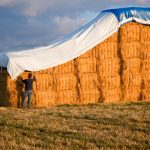Moldy Hay – Why Hay Covers Are A Farmer’s Best Friend
Posted by Canopies Tarps on Sep 27th 2016
Livestock owners know the symptoms of moldy hay. The hay smells musty, throws off dust when broken apart, and may even contain the tell-tale black or gray mold spores in the middle of the bale. But with high hay prices, it is tempting to feed moldy hay. After all, if the animals still eat it, how harmful can it really be?
Moldy hay poses many dangers. First of all, moldy hay is harmful to the humans handling the hay. Mold spores inhaled by a human irritate the lungs, and aggravate existing respiratory issues such as asthma.
The dangers of respiratory issues are also present for the livestock consuming the hay. In addition to breathing in the mold spores, livestock who eat moldy feed experience a decline in appetite, a loss of productivity, and increased reproductive issues. These issues are exacerbated in high production animals such as dairy cattle.
So what to do? First of all, buy from a reputable source. Hay becomes moldy if it is not properly dried before being baled. Next, inspect all hay before feeding. A hungry animal will eat almost anything put in front of it. Do not rely on the livestock to tell you if the hay is good or not. Check for dust, musty smells, or mold spores, especially in the middle of the bale.
Lastly, protect your supply! Hay molds whenever it is exposed to damp conditions or rain. Keep your hay bales stored on a dry surface. If your barn has dirt flooring, invest in a quality tarp. If you must store your hay outdoors, a hay cover is absolutely essential. For more information on products that can keep your hay safe and dry, contact us.


